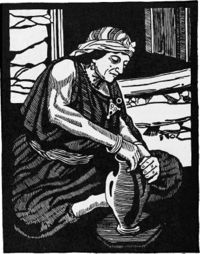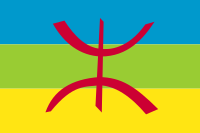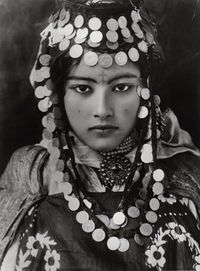قبائل (أمازيغ)
| التعداد الإجمالي | |
|---|---|
| (6-9 مليون) | |
| المناطق ذات التواجد المعتبر | |
| 8,7 مليون | |
| 545,000 مليون | |
| 60,000 مليون | |
| 80,000 مليون | |
| اللغات | |
| القبائيلية | |
| الديانة | |
| مسلمون سنة، كاثوليك, پروتوستنت، ملحدون | |
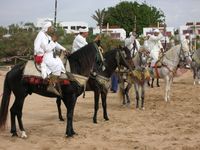
القبائل هم مجموعة أمازيغية في الجزائر وشمال أفريقيا. وتعتبر من أكبر المجموعات العرقية في الجزائر، ويقطنون منطقة القبائل شمال الجزائر، على بعد 100 ميل من الجزائر العاصمة. منذ بداية القرن العشرين، كان لهم حضور قوي في منطقة الجزائر العاصمة، ويشكلون حوالي 40% من إجمالي سكان المدينة.
التاريخ
الانتشار
يعيش القبائيليون بصفة رئيسية في منطقة جبال الكبرى القبائيلية (المنطقة التاريخية للقبائل) وتقع شرق الجزائر العاصمة. ويقدر أعدادهم في مدينة الجزائر بحوالي 30 مليون شخص، حسب تعداد 2007. ويعيش منهم في فرنسا حوالي 676 ألف شخص، وفي بلجيكا 50 ألف شخص، المملكة المتحدة 3 آلاف شخص. ويقدر إجمالي عدد القبائل حول العالم بحوالي 4-6 مليون شخص.
اللغة
اللغة الرئيسية التي يتحدثها أبناء القبائل هي القبائيلية. ويتحدث بعضهم الفرنسية، العربية والإنگليزية.
الديانة
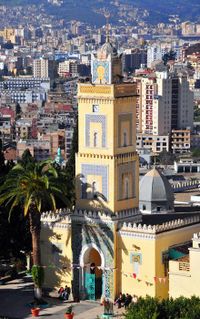
يدين معظم القبائليين بالإسلام وبعضهم بالمسيحية.[1]
العلم
يتكون علم الأمازيغ من ثلاث خطوط أفقية، الأزرق، الأخضر الفاتح، والأصفر، ورحوف تشبه حرف M.
الاقتصاد
يعتمد الاقتصاد التقليدي لأبناء القبائل على زراعة الحقول وأشجار الزيتون ويحترف بعضهم صناعة النسيج والفخار.
بدأ الثورة الصناعية مبكرا في منطقة القبائل، ففي عام 1871، كان لديهم بعض المصانع بالفعل، لكن في منتصف القرن العشرين، وبفعل هجرة أبناء المنطقة، وتأثير المناطق الحضرية المجاورة لهم، إزدادت أهمية الصناعة في اقتصاد أبناء القبائل، وأصبحت منطقة القبائل ثاني أهم المناطق بعد مدينة الجزائر.
السياسة
يعتبر جبهة القوى الاشتراكية بزعامة حسين آيت أحمد، والتجمع من أجل الثقافة والديمقراطية بزعامة سعيد سعدي من أبرز الأحزاب السياسية القبائيلية. وهما من الأحزاب العلمانية الأمازيغية الجزائرية.
- The Arouch emerged during the Black Spring of 2001 as a revival of a traditional Kabyle form of democratic organization, the village assembly. The Arouch share roughly the same political views as the FFS and the RCD.
- The MAK (Movement for the Autonomy of Kabylie) also emerged during the Black Spring, and is a political association that militates for the autonomy of Kabylie.
- On 21 April 2010, Ferhat Mehenni, the then leader of the (Movement for the autonomy of Kabylie) proclaimed a Provisional Government of Kabylia in exile (ANAVAD) which was established officially on 1 June 2010 at the Palais des Congrès. He was elected President by the National Council of the MAK and he named nine Ministers.[2]
التاريخ
العصر الحديث
الإستعمار الفرنسي
The Kabyles were relatively independent of outside control until the area was gradually taken over by the French beginning in 1857, despite vigorous resistance by the population led by leaders such as Lalla Fatma n Soumer, continuing as late as Mokrani's rebellion in 1871. Much land was confiscated in this period from the more recalcitrant tribes and given to French pieds-noirs. Many arrests and deportations were carried out by the French, mainly to New Caledonia (see : "Algerians of the Pacific"). Colonization also resulted in an acceleration of the emigration into other areas inside and outside Algeria.
Algerian immigrant workers in France organized the first party promoting independence in 1920s. Messali Hadj, Imache Amar, Si Djilani, and Belkacem Radjef rapidly built a strong following throughout France and Algeria in 1930s and actively developed militants that became vital to the future of both a fighting and an independent Algeria. During the war of independence (1954–1962), Kabylia was one of the areas that was most affected, because of the importance of the maquis, aided by the mountainous terrain, and French oppression. The armed Algerian revolutionary resistance to French colonialism, the National Liberation Front (FLN) recruited several of its historical leaders there, including Hocine Aït Ahmed, Abane Ramdane, and Krim Belkacem.
بعد إستقلال الجزائر
Tensions have arisen between Kabylia and the central government on several occasions, initially in 1963, when the FFS party of Hocine Aït Ahmed contested the authority of the single party (FLN). In 1980, several months of demonstrations demanding the officialization of the Berber language took place in Kabylie, called the Berber Spring. The politics of identity intensified as the regime's policy of Arabization was implemented to appease Islamists in the 1990s. In 1994–1995, a school boycott occurred, termed the "strike of the school bag". In June and July 1998, the area blazed up again after the assassination of singer Matoub Lounes and at the time that a law generalizing the use of the Arabic language in all fields went into effect. In the months following April, 2001 (called the Black Spring), major riots — together with the emergence of the Arouch, neo-traditional local councils — followed the killing of a young Kabyle Masinissa Guermah by gendarmes, and gradually died down only after forcing some concessions from the President, Abdelaziz Bouteflika.
الشتات
For historical reasons, many Kabyles have emigrated to France, where they number about 1.5 million.[3][4] Many famous French people such as Zinedine Zidane, Isabelle Adjani, Kenza Farah, Dany Boon, and Edith Piaf[5] are of full or partial Kabyle descent.
علم الوراثة
- Y-Dna haplogroups, passed on exclusively through the paternal line, were found at the following frequencies in Kabylie : E1b1b1b (E-M81) (47.36%), R1*(xR1a) (15.78%) (later tested as R1b3/R-M269 (now R1b1b2)[6]), J1 (15.78%), F*(xH, I,J2,K) ( 10.52% ) and E1b1b1c (E-M123) (10.52%).[7] The North African pattern of Y-chromosomal variation (including both E1b1b and J haplogroups) is largely of Neolithic origin.
- MtDNA Haplogroups, by contrast, inherited only from the mother, were found at the following frequencies : H (32.23%), U* (29.03% with 17.74% U6), preHV (3.23%), preV (4.84%), V (4.84%), T* (3.23%), J* (3.23%), L1 (3.23%), L3e (4.84%), X (3.23%), M1 (3.23%), N (1.61%) and R (3.23%).
انظر أيضا
المصادر
- ^ « Kabyle », Encyclopædia Britannica Online, 2011 : « they are mainly Muslims with a few Christians. » Consulted June 10, 2011.
- ^ http://www.kabylia-gov.org
- ^ Salem Chaker, Pour une histoire sociale du berbère en France, Les Actes du Colloque Paris - Inalco, octobre 2004
- ^ "Outside North Africa, the largest Kabyle community, numbering around 1.5 million, is in France", James Minahan, Encyclopedia of the Stateless Nations: D-K, ood Publishing Group, 2002, p.863
- ^ "Her mother, half-Italian, half-Berber", David Bret, Piaf: a passionate life, Robson Books, 1998, p.2
- ^ Adams et al. 2008, The genetic legacy of religious diversity and intolerance: paternal lineages of Christians, Jews, and Muslims in the Iberian Peninsula
- ^ Arredi B, Poloni ES, Paracchini S, Zerjal T, Fathallah DM, Makrelouf M, Pascali VL, Novelletto A, Tyler-Smith C. (2004). "A Predominantly Neolithic Origin for Y-Chromosomal DNA Variation in North Africa". Am J Hum Genet. 75 (2): 338–345. doi:10.1086/423147. PMC 1216069. PMID 15202071.
{{cite journal}}: CS1 maint: multiple names: authors list (link)
وصلات خارجية

